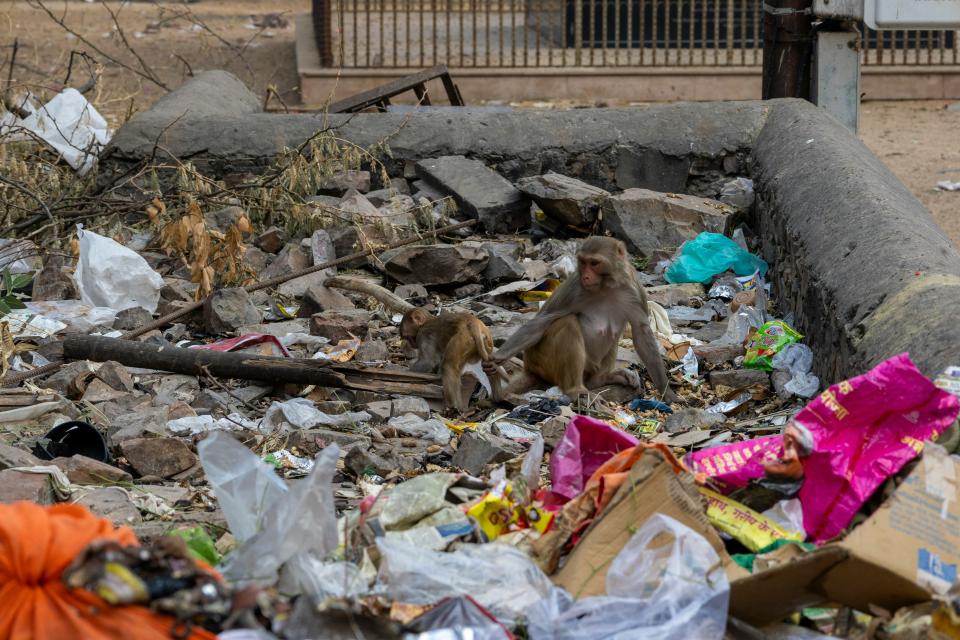In 2012, the activist group Waste Warriors was founded to tackle the growing problem of waste management in the Indian Himalayan region. Recognizing the mounting threats that plastic pollution posed to wildlife and natural ecosystems, Waste Warriors began working in partnership with local communities and governmental agencies to protect the fragile environment of Himachal Pradesh and Uttarakhand. Their efforts reflect a broader need to understand how human waste, especially plastic, is aging mountain landscapes and endangering wildlife such as the Himalayan brown bear.
The Himalayan brown bear (Ursus arctos isabellinus), a subspecies of the brown bear with only 500 to 750 remaining in the wild, has faced increasing threats from human plastic consumption since the early 2000s. Although the broader species (Ursus arctos) is classified as Least Concern by the International Union for Conservation of Nature (IUCN), this subspecies is recognized by local conservation groups as highly threatened due to its small population and the rapid loss of its alpine habitat. Drawing on recent findings in ecological research, this article highlights how human waste alters natural ecosystems in the Indian Himalayas and threatens the survival of wildlife like the Himalayan brown bear.

Himalayan brown bears in Kugti Wildlife Sanctuary, Himachal Pradesh.
Himalayan brown bears in Kugti Wildlife Sanctuary, Himachal Pradesh.
Photograph by Niazulkhan. Click here to view Wikimedia source.
 This work is licensed under a Creative Commons Attribution 4.0 International License.
This work is licensed under a Creative Commons Attribution 4.0 International License.
Traditional challenges like poaching, the encroachment of human and livestock populations, and the bears’ strong dependency on dwindling natural resources and alpine pastures remain key threats to the survival of their species. However, recent studies suggest that 75 percent of the bears’ diet now consists of scavenged waste from human dump sites. This dietary shift reduces nutritional intake and introduces toxic materials that could impact their health, further threatening a vulnerable population. The increased accessibility to waste is caused by the expansion of tourism and infrastructure development in the Indian Himalayan region, where inadequately managed waste disposal creates a dangerous overlap between human and wildlife habitats.
Wild animals have increasingly been observed near the edges of protected areas such as the Shivalik Elephant Reserve and Kugti Wildlife Sanctuary, often searching for food from nearby waste sites. These animals are responding to a landscape drastically altered by human development. The expansion of tourism, infrastructure, and settlement has fragmented forests and pushed human waste into previously undisturbed ecosystems, forming new spaces where wildlife and waste intersect. The widespread availability of waste for wildlife consumption harms terrestrial ecosystems. In some regions, over 80 percent of the animals found at waste dumps are wild species, including bears, elephants, storks, and crows, putting them at significant risk from plastic ingestion. Animals with less dexterity while eating, such as birds, ingest more plastic, amplifying health risks. This dependency on waste undermines natural dietary habits and survival, directly linking wildlife struggles to human expansion in these mountain ecosystems.
Plastic waste contains harmful chemicals like bisphenol A (BPA), which can negatively affect animal health, reproduction, neurological systems, embryonic development, and mortality rates. Pathogens, such as Salmonella, and zoonotic diseases (which can be transferred from animals to humans) are also commonly found in waste dumps. Many animals accidentally eat plastic while scavenging in waste-ridden areas. This can block the digestive system, which can lead to starvation, ulceration, or perforation of the digestive tract, and, ultimately, mortal injuries. Wild animals also suffer from entanglement in plastic waste, which can create external wounds, impair movement and feeding, reduce fitness, and cause death.

Monkey on a pile of trash. Rajasthan, India.
Monkey on a pile of trash. Rajasthan, India.
Photo by Martijn Vonk on Unsplash
This work is licensed under the Unsplash License.
Over the last few decades, the Indian Himalayan region has undergone rapid transformation through progressive development, with tourism as one of its fastest-growing sectors. Paradoxically, protected areas focused on conserving nature and endangered species have also become hot spots for ecotourism and infrastructure expansion. Tourists visiting these nature reserves leave behind plastic and other waste materials that accumulate and harm the landscapes they come to admire. In this way, conservation spaces unintentionally morph into “harmscapes,” where wildlife like the Himalayan brown bear are exposed to dangerous human waste. Their popularity brings in activity that damages the ecological balance and transforms protected zones into risk sites.
The issue is exacerbated by inadequate solid-waste management infrastructure, especially in remote and mountainous areas. The extreme climate and challenging topography of highland communities make it difficult to implement effective systems. This has led to reliance on improper disposal methods such as dumping and burning, which harm wildlife and damage ecosystems by polluting freshwater streams and releasing pollutants that accelerate glacier melt. In some areas, local dumping has emerged from inadequate infrastructure and accessible waste-management education. Growing tourism has further increased waste generation, straining the already inadequate infrastructure system.
To minimize the impact of waste on wildlife, waste management must account for the needs of nonhuman life. Activist groups like Waste Warriors have significantly improved waste management by collaborating with local communities to codesign and implement systems, enhance infrastructure, inspire governments, promote entrepreneurship, and overcome the social stigma of waste work. Some community members have stepped into leadership roles, with attitudes toward waste and conservation shaped by complex place-based relationships with the land. Since 2012, Waste Warriors has collected and sorted 5,570 metric tons of waste and actively involved 160,000 people.
Moreover, they work with multiple government bodies – including forest departments (e.g., in northeastern India), tourism departments, local governance bodies (e.g., Panchayati Raj), pollution control boards, and departments of science, technology, and urban and rural development – to align solid waste policy. Waste Warriors also work alongside agencies such as the Centre for Public Policy and Good Governance (Uttarakhand) to help address human-caused environmental challenges, contributing to wildlife protection one step at a time.
How to cite
McFarland, Maile. “Plastics in the Peaks: The Hidden Threat to Himalayan Wildlife.” Environment & Society Portal, Arcadia (Spring 2025), no. 5. Rachel Carson Center for Environment and Society. doi:10.5282/rcc/9951.
ISSN 2199-3408
Environment & Society Portal, Arcadia
 This work is licensed under a Creative Commons Attribution 4.0 International License.
This work is licensed under a Creative Commons Attribution 4.0 International License.
2025 Maile McFarland
This refers only to the text and does not include any image rights.
Please click on an image to view its individual rights status.
- Gibble, R. E., and K. N. Baer. “Effects of Atrazine, Agricultural Runoff, and Selected Effluents on Antimicrobial Activity of Skin Peptides in Xenopus Laevis.” Ecotoxicology and Environmental Safety 74, no. 4 (2011): 593–99. https://doi.org/10.1016/j.ecoenv.2010.11.009.
- Himalayan Brown Bear (Ursus arctos isabellinus): Ecological and Human-Bear Conflict Investigation in Kashmir with Special Reference to Bear Habituation to Garbage Dumps in the Central Wildlife Division, July 2021–October 2021. Wildlife SOS, 2022. https://apistaging.iucnredlist.org/en/species/41688/216873475#assessment-information.
- Katlam, Gitanjali, Soumya Prasad, Mohit Aggarwal, and Raman Kumar. “Trash on the Menu.” Current Science 115, no. 12 (2018): 2322–26. https://doi.org/10.18520/cs/v115/i12/2322-2326.
- Newsome, Thomas M., and Lily M. Van Eeden. “The Effects of Food Waste on Wildlife and Humans.” Sustainability 9, no. 7 (2017): 1269. https://doi.org/10.3390/su9071269.
- Puri, Kanchan, Ritesh Joshi, and Vaibhav Singh. “Open Garbage Dumps near Protected Areas in Uttarakhand: An Emerging Threat to Asian Elephants in the Shivalik Elephant Reserve.” Journal of Threatened Taxa 12, no. 11 (2020): 16571–75. https://doi.org/10.11609/jott.4392.12.11.16571-16575.
- Sapolsky, Robert M., and James G. Else. “Bovine Tuberculosis in a Wild Baboon Population: Epidemiological Aspects.” Journal of Medical Primatology 16, no. 4 (1987): 229–35. https://doi.org/10.1111/j.1600-0684.1987.tb00331.x.
- Thakur, Aman, Sareeka Kumari, Shruti Sinai Borker, Swami Pragya Prashant, Aman Kumar, and Rakshak Kumar. “Solid Waste Management in Indian Himalayan Region: Current Scenario, Resource Recovery, and Way Forward for Sustainable Development.” Frontiers in Energy Research 9 (2021): 609229. https://doi.org/10.3389/fenrg.2021.609229.








